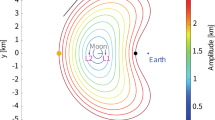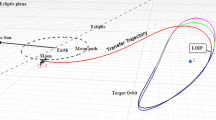Abstract
The invariant manifolds of libration point orbits (LPOs) in the Sun-Earth/Moon system are used to construct low-energy transfers from Low Earth Orbits (LEOs) to geosynchronous orbits. A maneuver is performed in LEO to insert onto a stable manifold trajectory of an LPO. The spacecraft travels to the host LPO and then follows an unstable manifold trajectory back to a geosynchronous orbit, where an orbit insertion maneuver is performed. The gravitational effects of the Sun-Earth/Moon three-body system act in such a way that large plane changes between the initial and final orbits at Earth may be realized without the execution of any plane change maneuvers. The maneuver costs of the transfers that employ invariant manifolds are compared to those using traditional techniques. The transfers that employ manifold trajectories can lower the cost of traditional Hohmann transfers by up to 3.15 km/s for transfers involving large differences in initial and final inclinations. The decrease in fuel expenditure is accompanied by an increase in time of flight; transfer durations are slightly over one year.
Similar content being viewed by others
References
KELSO, T. “CelesTrak,” http://celestrak.com, April 2010.
HOHMANN, W. Die Erreichbarkeit Der Himmelskörper: Untersuchungen über Das Raumfahrtproblem, Munich, Oldenbourg, 1925.
HOELKER, R.F. and SILBER, R. “The Bi-Elliptical Transfer Between Co-Planar Circular Orbits,” Planetary and Space Science, Vol. 7, 1961, pp. 164–175.
IVASHKIN V.V. and TYPITSYN, N.N. “Use of the Moon’s Gravitational Field to Inject a Space Vehicle into a Stationary Earth-Satellite Orbit,” Cosmic Research, Vol. 9, No. 2, 1971, pp. 163–172.
OCAMPO, C. “Trajectory Analysis for the Lunar Flyby Rescue of AsiaSat-3/HGS-1,” New York Academy Sciences Annals, Vol. 1065, Dec. 2005, pp. 232–253.
TURNER, A.E. “Geosynchronous Orbit via the Moon: Phasing Loops to Permit Daily Launch,” presented as paper AAS 10-130 at the AAS/AIAA Spaceflight Mechanics Meeting, San Diego, CA, February 2010.
CHOW, N., GRALLA, E., CHASE, J., and KASDIN, N. “Low Earth Orbit Constellation Design Using the Earth-Moon L1 Point,” presented as paper AAS 04-248 at the 14th AAS/AIAA Spaceflight Mechanics Meeting, Maui, February 8–12, 2004.
HERRERA, E. “Study of LEO to GEO Transfers via the L1 Sun-Earth or Earth-Moon Libration Points,” Master’s thesis, Polytechnic University of Catalonia, 2008.
LO, M.W., WILLIAMS, B.G., BOLLMAN, W.E., HAN, D.S., HAHN, Y.S., et al. “Genesis Mission Design,” The Journal of the Astronautical Sciences, Vol. 49, January–March 2001, pp. 169–184.
HOWELL, K.C., BARDEN, B.T., WILSON, R.S. and LO, M.W. “Trajectory Design Using a Dynamical Systems Approach with Application to Genesis,” presented as paper AAS 97-709 at the AAS/AIAA Astrodynamics Specialist Conference, Sun Valley, Idaho, August 4–7, 1997.
HOWELL, K.C., BARDEN, B.T., and LO, M.W., “Application of Dynamical Systems Theory to Trajectory Design for a Libration Point Mission,” The Journal of the Astronautical Sciences, Vol. 45, April–June 1997, pp. 161–178.
PARKER J.S. and BORN, G.H. “Modeling a Low-Energy Ballistic Lunar Transfer Using Dynamical Systems Theory,” Journal of the Spacecraft and Rockets, Vol. 45, No. 6, 2008, pp. 1269–1281.
NAKAMIYA, M., SCHEERES, D., YAMAKAWA, H., and YOSHIKAWA, M. “Analysis of Capture Trajectories into Periodic Orbits about Libration Points,” Journal of Guidance, Control, and Dynamics, Vol. 31, September–October 2008, pp. 1344–1351.
GÓMEZ, G., KOON, W.S., LO, M.W., MARSDEN, J., MASDEMONT, J.E., and ROSS, S.D. “Invariant Manifolds, the Spatial Three-Body Problem and Space Mission Design,” presented as paper AIAA 01-301 at the AIAA/AAS Astrodynamics Specialist Meeting, Quebec City, Canada, August 2001.
GÓMEZ G. and MASDEMONT, J. “Some Zero Cost Transfers Between Libration Point Orbits,” presented as paper AAS 00-177 at the AAS/AIAA Spaceflight Mechanics Meeting, Clearwater, Florida, January 2000.
GÓMEZ, G., KOON, W.S., MARSDEN, J.E., MASDEMONT, J., and ROSS, S.D. “Connecting Orbits and Invariant Manifolds in the Spatial Restricted Three-Body Problem,” Nonlinearity, Vol. 17, September 2004, pp. 1571–1606.
KOON, W.S., LO, M.W., MARSDEN, J.E., and ROSS, S.D. “Heteroclinic Connections Between Periodic Orbits and Resonance Transitions in Celestial Mechanics,” Chaos, Vol. 10, No. 2, 2000, pp. 427–469.
DAVIS, K.E., ANDERSON, R.L., SCHEERES, D.J., and BORN, G.H. “Locally Optimal Transfers Between Libration Point Orbits Using Invariant Manifolds,” presented as paper AAS 09-398 at the AAS/AIAA Astrodynamics Specialists Conference, Pittsburgh, PA, February 8–12, 2009.
VILLAC B.F. and SCHEERES, D.J. “New Class of Optimal Plane Change Maneuvers,” Journal of Guidance, Control, and Dynamics, Vol. 26, No. 5, 2003, pp. 750–757.
VILLAC B.F. and SCHEERES, D.J. “Third-Body Driven vs. One-Impulse Plane Change,” Advances in the Astronautical Sciences, Vol. 57, No. 3, 2010.
SZEBEHELY, V. Theory of Orbits: The Restricted Problem of Three Bodies, New York, Academic Press, 1967.
KOON, W.S., LO, M.W., MARSDEN, J.E., and ROSS, S.D. Dynamical Systems, the Three-Body Problem and Space Mission Design, Marsden Books, 2008.
MOULTON, F.R. Periodic Orbits, Washington, Carnegie Institution of Washington, 1920.
BROUCKE, R.A. “Periodic Orbits in the Restricted Three-Body Problem with Earth-Moon Masses,” Technical Report 32-1168, Jet Propulsion Laboratory, Cal. Tech., 1968.
FARQUHAR, R.W. and KAMEL, A.A. “Quasi-Periodic Orbits about the Translunar Libration Point,” Celestial Mechanics, Vol. 7, June 1973, pp. 458–473.
BREAKWELL, J.V. and BROWN, J.V. “The Halo Family of Three-Dimensional Periodic Orbits in the Earth-Moon Restricted Three-Body Problem,” Celestial Mechanics, Vol. 20, November 1979, pp. 389–404.
GÓMEZ, G., JORBA, A., LLIBRE, J., MARTINEZ, R., MASDEMONT, J. and SIMÓ, C. Dynamics and Mission Design near Libration Points, Vol. I–IV. Singapore: World Scientific Publishing Co., 2001.
FARQUHAR, R.W. “The Utilization of Halo Orbits in Advanced Lunar Operations,” Technical Report, NASA TN D-6365, July 1971.
PAFFENROTH, R.C., DOEDEL, E.J. and DICHMANN, D.J. “Continuation of Periodic Orbits Around Lagrange Points and AUTO2000,” presented as paper AAS 01-303 at the AAS/AIAA Astrodynamics Specialist Conference, Quebec City, Quebec, July 30–August 2, 2001.
HÉNON, M. “New Families of Periodic Orbits in Hill’s Problem of Three Bodies,” Celestial Mechanics and Dynamical Astronomy, Vol. 85, 2003, pp. 223–246.
WILSON, R. “Derivation of Differential Correctors Used in GENESIS Mission Design,” Technical Report JPL IOM 312.I-03-002, Jet Propulsion Laboratory, 2003.
RICHARDSON, D.L. “Analytical Construction of Periodic Orbits about the Collinear Points,” Celestial Mechanics, Vol. 22, 1980, pp. 241–253.
HOWELL, K.C. “Three-Dimensional, Periodic, ‘Halo’ Orbits,” Celestial Mechanics, Vol. 32, No. 1, 1984, pp. 53–71.
DAVIS, K.E., ANDERSON, R.L., SCHEERES, D.J., and BORN, G.H. “The Use of Invariant Manifolds for Transfers between Unstable Periodic Orbits of Different Energies,” Celestial Mechanics and Dynamical Astronomy, Vol. 107, No. 4, 2010, pp. 471–485.
Author information
Authors and Affiliations
Rights and permissions
About this article
Cite this article
Davis, K.E., Anderson, R.L. & Born, G.H. Preliminary Study of Geosynchronous Orbit Transfers from LEO using Invariant Manifolds. J of Astronaut Sci 58, 295–310 (2011). https://doi.org/10.1007/BF03321172
Published:
Issue Date:
DOI: https://doi.org/10.1007/BF03321172




